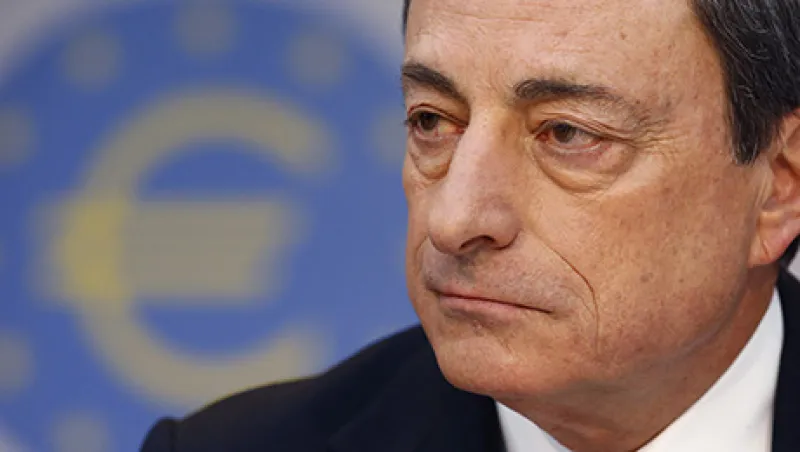A toxic spiral of low inflation coalescing with poor prospects for economic growth looks ready to emerge in the euro zone. Because of the member states’ ballooning debt, deflation is a major threat in the region. The euro zone’s inflation rate has fallen by 50 basis points since the beginning of the year, to 0.3 percent in November 2014, falling quite short of the European Central Bank’s 2 percent target. In a recent Bloomberg poll, 89 percent of responding investors saw deflation as a greater threat to the region’s economy than inflation in 2015. Further, Brent crude prices have plunged by more than 50 percent since June, adding fuel to the fire. U.K.-based financial analysis firm Oxford Economics estimated that with oil in its present slump, 13 European countries will see their inflation rates fall below zero in 2015. Yet the economic climate in Western Europe presents an opportunity for investors to reassess their equity portfolio allocation strategy.
All indications suggest that the ECB has run out of conventional monetary policy tools to counter the matter effectively. The euro zone benchmark rate has progressively fallen to 0.05 percent, whereas deposits have already entered negative territory. And then there are external factors that aren’t exactly helping the situation, such as the aggressive monetary policies of several other central banks.
Abenomics in Japan, for instance, is effectively exporting deflation to Europe. We have seen the yen depreciate with respect to the euro and the U.S. dollar, putting other economies under pressure to slash prices and costs to remain competitive. Only unconventional measures like full-blown quantitative easing (QE) might prove to be a game changer. Yet despite ECB president Mario Draghi’s recent speech in which he said that the ECB was ready to “step up the pressure” to fight inflation, such large-scale expansionary policies remain unlikely for two reasons.
First, purchasing a large amount of sovereign bonds from countries in the euro zone would violate the European Union treaty. Monetary financing is not allowed in the region, meaning that the ECB’s mandate is limited in scope and breadth. Second, Germany firmly opposes QE. Jens Weidmann, president of the Bundesbank, recently described bond purchases as “a dangerous path.” Other ECB governing council members have also expressed their concern. On December 10 Bank of Estonia governor Ardo Hansson said he was skeptical about the central bank’s purchasing government bonds on a large scale. Undertaking such a risky venture without broad support might lead to regional dissonance.
This particular macro environment specifically impacts equity investors, whose projected return on their portfolios might fail to materialize for a number of years. Equity markets still display some attractive traits, however, which might help investors navigate more effectively through the next few years.
Defensive stocks historically have been solid picks in economies facing deflationary threats and low growth. In particular, high-dividend stocks generally fare better than others in a deflationary economy, as dividend payments’ value effectively increases over time. We at Nasdaq conducted an analysis of the components of Nikkei 225 index from 1990 to 2010, the two purported “lost decades” for Japan, which were characterized by enduring deflation and lack of growth. Japan’s nominal gross domestic product, which is closely linked to deflation, barely grew over the period, with annualized returns of 0.4 percent.
The research showed that stocks with the highest dividend yield displayed positive annualized time-weighted returns (including dividends reinvestments), significantly outperforming over the period those with the lowest dividend yield — by 3.8 percentage points a year. (Interestingly, a separate analysis uncovered that investors who allocate assets in Europe are already hedging against the region’s gloomy prospects. European equity investments have been routed toward income-oriented funds, which have recorded significant inflows of $4.1 billion since the beginning of 2014, according to fund data provider Lipper.)
Probing deeper, other winners emerging from the two lost decades in Japan are companies that pioneered innovative products and materials — and whose prices were essentially immune to depreciation. Top performers (taking into account dividends reinvestments) from 1990 to 2010 included Canon, with 9 percent annual growth; medical equipment company Terumo Corp., which registered 7.4 percent a year during the 20-year period; and Takeda Pharmaceutical Co., which grew 6.1 percent on an annualized basis. Honda Motor Co., which was the first automaker to release a hybrid electric car in North America, in 1997, returned 8.7 percent a year to its shareholders from 1990 to 2010.
European equity markets show similar trends. Significant R&D investments and innovation-led mergers provide a good indicator of companies' ability to perform in this period of low inflation. Health care and technology sectors include an array of stocks able to maintain healthy profit margins and strong pricing power in this context. The Stoxx pharmaceuticals and biotechnology European indexes, which include some of the most innovative European companies, each outperformed the Stoxx Europe 600 index in 2014 by 14 and 3 percentage points, respectively.
A new normal of low inflation and feeble growth appears to be slowly emerging in Western Europe. Investment opportunities should nonetheless arise in equity capital markets for investors who are more tolerant of risk, however, notably stretched valuation and failure to deliver upon growth prospects. It’s time to rethink European equity portfolio allocation strategy. Watch this space.
Nicolas Hourcard is a European equities analyst with Nasdaq Advisory Services in London.
The opinions expressed in this article are those of the author and don’t necessarily reflect those of Nasdaq.
Get more on equities .






